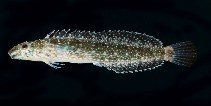| Family: |
Blenniidae (Combtooth blennies), subfamily: Blenniinae |
| Max. size: |
5.9 cm SL (male/unsexed) |
| Environment: |
demersal; marine; depth range 1 - 5 m |
| Distribution: |
Western Central Pacific: Moluccas, New Guinea, Solomon Islands; Belau and Yap in Micronesia. |
| Diagnosis: |
Dorsal spines (total): 10-11; Dorsal soft rays (total): 16-18. Closely related to P. variabilis, but is usually more elongate and has a bulbous or elongate snout. |
| Biology: |
Adults inhabit weedy areas such as Sargassum beds. They occur in shallow seagrass beds where they hide by pressing itself against a blade of seagrass. Oviparous. Eggs are demersal and adhesive (Ref. 205), and are attached to the substrate via a filamentous, adhesive pad or pedestal (Ref. 94114). Larvae are planktonic, often found in shallow, coastal waters (Ref. 94114). |
| IUCN Red List Status: |
Least Concern (LC); Date assessed: 25 March 2009 Ref. (130435)
|
| Threat to humans: |
harmless |
| Country info: |
|
Source and more info: www.fishbase.org. For personal, classroom, and other internal use only. Not for publication.

